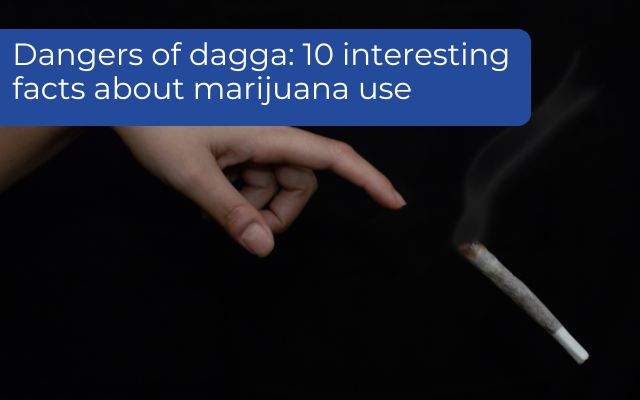Weed can affect your sex life, the brains of teens and dagga is addictive to one in 10 people who use it and why smoking dagga may impact us in these ways as well as for an in-depth look at seven other interesting facts about dagga you might not know.
Dagga refers to the dry material harvested from the Cannabis Indica or Cannabis Sativa plant that is usually smoked but can be consumed in a number of other ways.
The active ingredient, THC, causes a high as well as a number of short- and long-term consequences.

Fees, Funding, and What’s Included
Transparent costs and benefits help families plan and avoid surprises.
10 Facts About Dagga
Dagga is addictive
Statistics show that between nine and 30% of regular dagga users develop an addiction or substance use disorder. According to an American study, while 2.9% of the total population had a dagga use disorder in the past year, in those who used dagga, 30.6% were classified as having a cannabis use disorder.
Cannabis use disorder is a medically-accepted term used to classify people with an addiction to dagga which includes “adverse consequences, loss of control over use, and symptoms”. Cannabis use disorder can range from mild to severe, according to the World Health Organization.
Severe cannabis use disorders, marked by a strong dependence on the drug, occur in one in 10 people who smoke weed. However, this estimate increases to one in six people if users start smoking before the age of 18.
Dagga can negatively impact your sex life
There are a number of studies that suggest that dagga use is associated with higher-than-normal rates of risky sexual behaviour and sexually transmitted infections, especially in young people and women.
A 2011 study conducted on young people in the juvenile justice system in the United States found that there was a significant association between dagga use and a decreased likelihood of condom use.
Another study on young women found that early and current dagga use was linked to a higher number of lifetime sexual partners.
However, the link has also been found to exist in men. A study on men found that those who were diagnosed with gonorrhoea more frequently reported having sex after using dagga during the preceding month.
Dagga has also been found to affect men when it comes to sexual pleasure. Men who were frequent cannabis users were more likely to experience an inability to reach orgasm as desired.
Long-term cannabis use can impact cognitive function and lower IQ
According to the World Health Organization, studies on regular dagga users “have consistently found deficits in verbal learning, memory and attention”. These deficits are most significant in users who started smoking cannabis at an early age and those who have used the drug for a very long time.
It remains unclear if these deficits can be reversed after a person stops using weed.
Moreover, a study conducted in New Zealand found that a person’s IQ can decrease by as much as eight points if they are a long-term regular user of dagga.
The negative impact of dagga use is worse in children and adolescents
Evidence shows that heavy and regular cannabis use in childhood and adolescence has a more severe and long-lasting negative impact when compared to dagga use in adulthood.
Younger brains tend to be more vulnerable to the negative impact of weed than the brains of adults.
The cognitive deficits seen in adolescents are similar to those seen in adults but they are more long-lasting and less likely to be reversible after cannabis use is stopped. These deficits include problems with attention, learning and memory.
Research has found that dagga use before the age of 15 is related to dropping out of school early. Long-term heavy cannabis use in children and adolescents is also associated with negative consequences later in life such as having a low income, being unemployed and using other drugs.
An Australian study also found that those who used dagga at a young age had higher rates of criminality and of being classified as juvenile offenders.
Dagga has been linked to mental illnesses
According to a summary of the evidence by the World Health Organization, using dagga with a higher THC content “may increase the risk for schizophrenia and lower the age of onset of the disease”.
This is especially true for people who start smoking the drug before adulthood. A 15-year follow-up study, that included data from over 50 000 men in Sweden, found that those who tried cannabis by the age of 18 were 2.4 times more likely to be diagnosed with schizophrenia than those who did not.
A 27-year follow up on the same cohort estimated that 13% of schizophrenia cases could have been prevented if none of the study participants had used dagga.
It has been found that people with cannabis use disorders have higher rates of depression but there is little evidence to suggest that dagga actually causes depressive disorders. The link may be due to the fact that people with depression use cannabis as a way to self-medicate.
People with dagga use disorders have also been found to have higher rates of anxiety, eating disorders and personality disorders but more research is needed to shed light on the exact nature of these associations.
THC levels have increased dramatically
According to the World Health Organization, there has been an increase in the average THC content in the dagga available in the United States over the past few decades. Other sources suggest this upward trend is not limited to America, but is a global phenomenon related to different growing and curing techniques that maximise THC content.
In the United States, THC content increased from less than 2% in 1980 to around 12 – 16% or higher more recently. In 2015 a number of American laboratories reported dagga products with a THC content of 20% or more.
Higher THC content is related to an increased risk of experiencing psychosis and developing schizophrenia as well as higher rates of cannabis use disorders and an increased risk for dagga intoxication- related car accidents.
For example, the use of high THC content products – with 15% THC or more – resulted in a three times increased risk of psychosis. If the use was daily then there was a five times increased risk. By comparison, those using hash with a THC content of 5% or less did not tend to show symptoms of psychosis.
Using dagga can cause heart and lung problems as well as strokes
Immediately after using dagga, a person’s heart rate and blood pressure increase. More often than not, these changes don’t cause severe consequences. However, there have been reports of dagga intoxication-related heart attacks and strokes.
Death related to heart problems was 2.5 times higher in people who used cannabis less than once a week and 4.2 times higher in those who used it once or more times a week compared to those who did not use the drug.
In 2015, an estimated 100 cases of cannabis-related strokes could be found in the scientific literature.
Long-term use of cannabis has been found to negatively impact the lungs with heavy users being more likely to report chronic cough, wheezing and bronchitis than non-users. These symptoms have been found to improve when a person quits smoking weed.
Studies have also suggested a link between smoking weed and an elevated risk of pneumonia.
Additionally, many smokers mix cannabis with tobacco and are therefore at risk of tobacco-related lung diseases such as chronic obstructive pulmonary disease and emphysema.
Driving high has been proven to lead to accidents
People driving while intoxicated with dagga are more at risk of having motor car accidents due to the fact that THC causes impairments in reaction time, information processing, coordination and attention.
In fact, people who drive while high on weed double their risk of having a car crash. Driving while intoxicated with cannabis is one the most important public health consequences related to this drug as it has been found to result in death. Furthermore, the risk has been found to increase in proportion to THC levels: The higher the level of THC in the blood, the higher the risk for a car accident.
Dagga has been legalised or decriminalised in a number of countries and territories
Uruguay became the first country to legalise the production, distribution and consumption of dagga for recreational purposes in 2013. In 2018, Canada legalised and began to regulate its domestic cannabis market. A total of 18 states in America have legalised recreational use of dagga. A number of countries have decriminalised recreational use including South Africa, Mexico and Portugal.
As laws are relaxed, recreational use of the drug has become more accepted and normalised in many societies. The perceived risks of dagga have also decreased.
This has had an impact on the number of recreational users which have increased substantially in recent years. The World Health Organization has stated that one of the most important risk factors for drug use has been “laws and norms favourable towards drug use”.
A consequence of increased drug use is a proportional increase in the harms associated with dagga, including the number of people becoming addicted to the drug or diagnosed with cannabis use disorders.
Using weed while pregnant can harm your baby
According to the World Health Organization, cannabis exposure during pregnancy can “interfere with normal development and maturation of the brain” of unborn babies.
Children exposed to dagga before birth have been found to have impaired attention, learning, memory and demonstrate impulsivity and behavioural problems as they age. They have also been found to be more likely to use cannabis themselves when they are older.
However, there is much less research on the impact of using dagga during pregnancy compared to alcohol or nicotine and further studies are needed for scientists to understand the impact more clearly and in more detail.
Many people consider dagga to be a harmless drug and non-addictive. The evidence shows that this is not true. We have explained the dangers of dagga in detail and according to the science.
Do you need help with an addiction to dagga? Contact us today.
Marijuana use can affect sexual health, impair adolescent brain development and increase abuse and addiction risk, with surprising dagga facts many miss.. Changes team counsellors are here to help you.Marijuana Use Abuse And Addiction Facts Revealed Now








